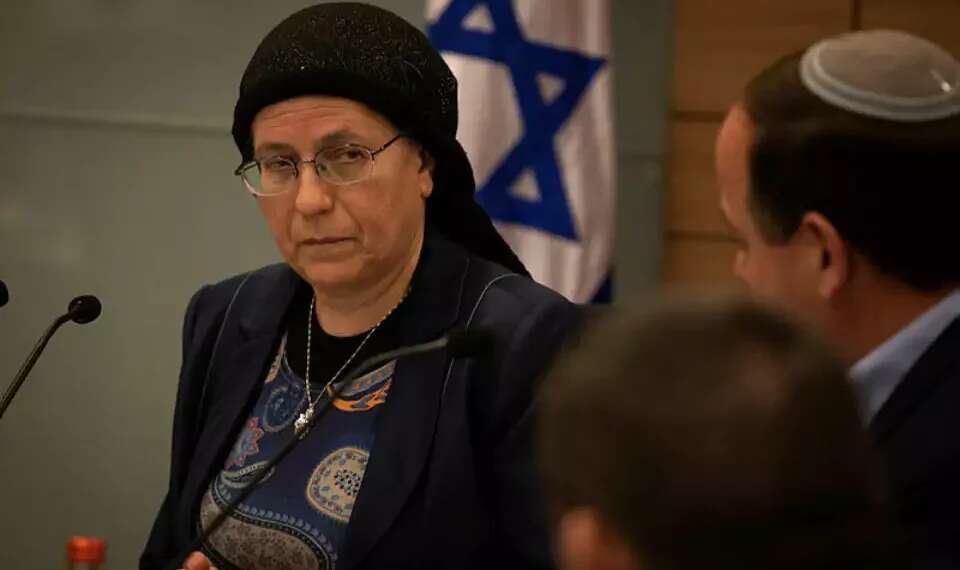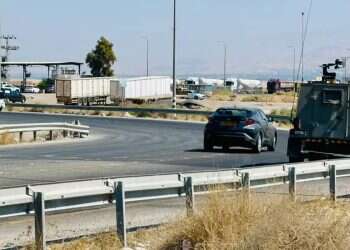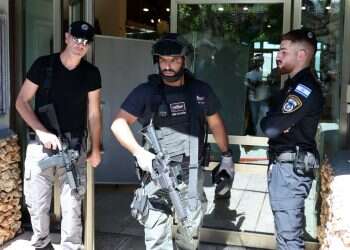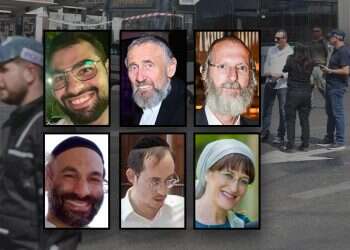Out of the gray skies over the Palmachim air base near Yavne, the sound of an engine erupted and was followed by the narrow body and extraordinarily broad wings of a Hermes 450 (Zik) drone cruising in all its glory. In a few hours, the Zik or a similar drone would launch a deadly and accurate missile at a Middle Eastern target. The world would once again be stunned by the intelligence and strike capabilities possessed by very few countries around the world.
Follow Israel Hayom on Facebook, Twitter, and Instagram
Israel's UAVs are no longer some kind of auxiliary force; they are a substantial element of Israel's aerial power. The Israeli Air Force, which now refers to them as "manned from a distance" aircraft as opposed to unmanned aerial vehicles, carried out 30,000 airstrikes during the three months of the war, most of them executed by the Zik, Kochav (Hermes 900), and Eitan (Heron TP) family of drones.
The IAF sends the best of the best – including fighter pilots – to command its UAV squadrons. They and the other operators treat their missions as flight duty in every respect. "I just flew over Gaza," says, Lt. Col. R., the commander of a UAV squadron.
There is a spark in his eyes and it is evident that he is pleased with every moment. Until recently, he was an F-16 navigator, and he plans to return to that role after completing this position. In the meantime, the experience he is acquiring in the "manned from a distance" division will only contribute to his advancement. The 161st Squadron that he currently leads looks and behaves exactly like a manned aircraft squadron. In addition to the planned missions, there are scrambles, drills, training, briefings, operations rooms, and flight overalls. These are fighter jets in every respect, only their cockpit is on the ground.
The surgical capabilities of the UAVs are much more suited to the nature of the current campaign than those of fighter jets, which are much heavier and much faster. The F series jets, the F 15s, 16s, and 35s, drop heavy bombs on buildings and return safely to their base. The Hermes 450 on the other hand is slow, equipped with many small missiles, can hover over the same area for hours, and therefore carry out a large number of attacks in a single sortie, lasting even 20 hours. UAVs have amazingly precise visual intelligence capabilities, as well as other tools to assist troops. In short, science fiction has come true.
R. himself has scored "just" 33 kills of terrorists. "I'm also busy managing the squadron," he apologizes, taking pride in his pilots who have more kills than he does. He shows us videos that illustrate the incredible coordination with ground forces, which is now tighter than ever before. The public is exposed only to the last seconds of the strikes with the call that has now become one of the iconic slogans of the war, "Two, three, fire." But in reality, the pursuit of even a lone terrorist from the ground and the air can last as long as an hour or even two.
From the "cockpit" in Palmachim, the operator speaks directly to ground forces in the field. Sometimes it is the ground forces who direct the drones and sometimes the drone directs them. Accuracy of fire within a range of meters is required. "I won't take any chances when it comes to the safety of our forces," says R. "That's why we put in such a great effort, even when it comes to just one suspect."
R. uploads another video for us to watch A terrorist is hiding in a house in the Zeitoun neighborhood. A tank fires a shell at the house, but the suspect quickly flees to another house. The tank is too big to enter the alley leading to the second house. The terrorist escapes, and all attempts to hit him fail. Finally, an F-16 pops up to drop a heavy bomb. The bomb does its job, but the terrorist escapes again. The Zik fires its payload and the terrorist returns his soul to Allah.
R.'s squadron has killed thousands of terrorists in similar scenarios, "and the count goes on." The claims of cases in which ground forces asked for assistance and received no response sound far-fetched to him. "I have no right to leave one terrorist alive if he endangers our forces," says R., explaining the operational rationale.
To show me how pleased the ground forces are with their aerial drone cover, he calls a forward ground squad, where one of Golani's battalion commanders is located. Against a backdrop of radio noise and commands being shouted out, the battalion commander says to R.: "Thank you for your trust. We've been together for a long time and things are going well. The operations are complex; there have been perhaps mishaps here and there, but they [the drones] are killing all the terrorists here in the Gaza Strip, and over time we have learned and improved our work methods." In his view, the cover and backing provided by R. and his squadron are outstanding.
The recordings and video clips that R plays for us show that the cooperation between air and ground forces is spectacular. This war is being conducted in particularly difficult terrain. From the ground or from the air, everyone sees the battle picture from their own angle. In general, the successes are enormous, but sometimes there are failures. There were cases in which ground forces actually asked the Zik to delay an attack and, in retrospect, it turned out that there was no justification to hold back a strike. Investigations are conducted.
Another challenge, one that has exacted a heavy price, is friendly fire. The pilots are very careful when asked for assistance. In one case, the Zik had already launched a missile that was headed for its target. Suddenly, the ground command unit warned that two soldiers were unaccounted for, and that there was concern about a blue-on-blue incident. The pilot diverted the munitions at the last minute, but a moment later it turned out that the soldiers had been located and the attack could be resumed. The target was locked on once more, a new missile was launched and a successful hit registered.
"Out of thousands of drone and helicopter strikes, there may have been occasional errors and misunderstandings here and there," says R. This was not said in a vacuum. There can be borderline situations, where, for example, someone will determine that the suspect is not endangering the soldiers, while someone else will say that he is. It is this confusion that perhaps led to recent claims of situations in which aerial forces have not provided assistance to ground forces. R. says that he is unaware of any such incidents. Both he and the army spokesperson's unit demand that those making these claims provide specific information and not just make general accusations so that the IDF will be able to debrief and improve. One particularly grave claim about an incident he had witnessed was made by a combat soldier fighting in Gaza, but sadly he was killed in action.
The soldier wrote a WhatsApp message: "For two hours we identified an unarmed terrorist watching us... for two hours the Zik operator refused to fire, claiming there were non-combatants nearby. This was in a combat environment in which anyone located there was automatically incriminated. After fierce arguments on the radio, the operator simply wouldn't shoot. Then (our comrade) received a bullet to the center of the face from the exact same place as the enemy spotter. He died for nothing."
The soldier's testimony found its way to Settlement Minister Orit Strook who then asked Maj. Gen. Eliezer Toledano, head of the IDF's Strategy Directorate, "Are there pilots who are refusing to assist ground forces for reasons of personal conscience?" Toledano didn't like what he was hearing. "That's a terrible question," he replied. Toledano's brazen remarks set the stage for a renewed series of attacks against the Minister."
Orit Strook was an innocent, small girl when she first got up and started asking questions. She was 16 years old, a high school student from Kiryat Yovel, a working-class neighborhood in Jerusalem, studying at the prestigious Hebrew University Secondary School. She was an outsider at the elitist institute.
Her questions led her to the late Rabbi Haim Druckman, under whom she became religious. From then until this day, Strook has stuck with her beliefs and with her questions, even when they don't curry favor with others. Together with her husband Abraham, she settled in the Jewish quarter of Hebron, and while bringing up 11 children she became involved in public life.
As the years passed, the scope of her public activity grew. From dealing with local issues, she moved on to issues affecting the entire Jewish community in Judea and Samaria. Thus, for example, she established the Yesha Human Rights Organization as a counter to left-wing organizations that cared only about Arab rights. She fought the "special procedures" initiated by then-attorney Shai Nitzan against Jewish residents of Judea and Samaria. Later, she sued police officers who beat up boys and girls during the evacuation of Amona in 2006.
The next stage in her career would be extra-parliamentary activism in the Knesset. Strook was the figure behind the Land of Israel Caucus, which she would establish after every election campaign. She made sure to include coalition and opposition representatives from the right and left in the caucus –something that has been typical of her activism ever since – this in contrast to the image of her built by the media. She herself stays largely behind the scenes.
Her work in the Knesset, and before that in Hebron, opened doors for her at the highest levels. Both the army and the political echelon have come to know a woman with a backbone and sharp thinking, who is devoid of personal interests. Several times a week she would travel by bus, about an hour and a half each way, from her home in Hebron to Jerusalem and back. Her devotion, close to the level of asceticism, has only increased appreciation for her. She, for her part, used the attention she gained to promote the issues on her agenda, not herself.
When Shalhevet Pass, a 10-month-old baby was murdered in Hebron in 2001, Benjamin Netanyahu, then a concerned citizen, felt a moral obligation and called to express condolences. In 2014, after the three boys were kidnapped, she called Naftali Bennett on the sabbath and proposed that Palestinians released in the Shalit deal be returned to prison. Bennett took the idea to Netanyahu, and the proposal was implemented.
Strook continued to ask her unconventional questions even when she became a Member of Knesset in 2021 (she also served as an MK in 2013-2015), and then as Minister of Settlements in 2023. In fact, she felt that her obligation to stick to her truth only grew as she took on more senior positions. As a member of the Foreign Affairs and Defense Committee after Operation Guardian of the Walls in May 2021, she asked IDF officers countless times why Israel allowed materials known to be used by Hamas to arm itself were allowed into the Gaza Strip. She rummaged through protocols, confronted the officers with things they or their predecessors had said in the past, and asked for answers that never came.
When she entered the government, a sole female voice in a security world dominated by men, she kept on asking questions. Strook, we can reveal here, was the only one in the current Israeli leadership to warn of Hamas' force build-up. When the entire political and defense leadership both in the coalition and the opposition, and the military, fell into Hamas' trap which put them to sleep – and Toledano as the head of Southern Command was one of them – Strook warned that "the day will come, when Hamas decides."
In a letter written on September 5 to Prime Minister Benjamin Netanyahu, to Defense Minister Yoav Gallant, to the head of the National Security Council Tzachi Hanegbi, and the rest of the cabinet and government – one of many letters she wrote – Strook asked why Israel was sending into Gaza "dual-purpose materials that will be sent back to us as missile warheads in the next conflict."
In that letter, a month before the war, when she despaired of the indifference of her colleagues, Strook chronicled her attempts to snap Netanyahu, Gallant, and the rest of the cabinet from their slumber.
"This letter is sent to you with great pain. The issue of the entry of dual-use materials into the Gaza Strip was raised by me at a government meeting on 23 Iyar 5783, 14 May 2023. I explained and proved at the time that the previous government had changed procedures and allowed the extensive entry of dual-use materials into the Gaza Strip, and I said that I expected us to change this erroneous decision. I issued a warning... I handed over the data to the Cabinet Secretary... The prime minister said he would examine the issue together with the cabinet.
"I also raised the issue in a meeting with the head of the National Security Council, to whom I also entrusted the same data, and in a letter to the defense minister. To the best of my knowledge (and I would be very happy to apologize if I'm wrong) – nothing has changed. I ask you to make sure that now data is examined seriously and that appropriate decisions be made."
From April through September 2023, Strook warned of Hamas' force-build up at least 15 times. "Most of the weapons and munitions of the terrorist organizations in the Gaza Strip are manufactured inside the Gaza Strip. Most of the materials used in their production enter Gaza from Israel," she wrote to Gallant in June 2023.
She notes that it was under the Bennett-Lapid government that restrictions on entry of materials into Gaza began to be lifted. "In January 2022, Israel allowed the entry of white cement into Gaza. In February 2022, steel sheets, and in December 2022, fiberglass. Throughout 2022, the government lifted restrictions on medical and communications equipment, which until then had been on the dual-use materials list. There is no doubt that these dual-use materials were exploited to renew the armament and force build-up of the terrorist organizations in Gaza and to rehabilitate the offensive capabilities of the terrorist organizations against us..." She received the information from the former head of the National Security Council, Meir Ben-Shabbat, who had issued warnings of his own, and from researchers at the Misgav Institute think tank, in a meeting she initiated with them in order to study the subject.
Strook is not only critical of the previous government but also of the government in which she is a member. "In January 2023 [under the Netanyahu government A.K.] boat engines were allowed into the Strip. In May, spare parts for motorcycles were allowed in … the stockpiles grew awaiting the order when Hamas decides. I would like to understand who decided on this policy and what their justifications are," she added.
On another occasion, she said: "The question of why additional and frequent actions are not taken to prevent armament and to damage any armament remains unanswered. I would like to ask this question again now... With the formation of the new government, it seemed evident that an end should be put to the Bennett-Lapid government's policy to prevent further armament, or at least minimize it. However, the policy has not been changed."
Strook wouldn't give up. She requested meetings, sent WhatsApp messages, and, sometimes, when she had really despaired, lectured the ministers on her views at government meetings. Netanyahu would call it the "Strook special procedure." He held her in esteem but didn't do much. And it wasn't just Netanyahu, the security establishment brushed her off. Former generals, especially those leaning left, dismissed her with typical condescension. Strong religious women, especially those with a head covering, put them off balance.
Former prime minister Yair Lapid, one of those who allowed dual-purpose materials into Gaza, described Strook's questioning of Toledano as "shocking incitement." He and others subject Strook to character assassination of the type that would with any other woman be described as misogyny.
But the right's iron lady will not be broken and will not change her ways. Unlike how she is portrayed in the media, Strook is one of the most unifying and effective figures in the government. On the wall of her office hangs a letter of appreciation from the heads of left-affiliated settlement movements.
"We thank Minister Orit Strook from the bottom of our hearts," wrote Eitan Broshi (former secretary-general of the Kibbutz Movement), Danny Ivry (head of the Misgav Regional Council), Nir Meir (the current secretary-general of the Kibbutz Movement), Amit Yifrach (secretary general of the Moshavim Movement), and others. The reason for the surprising recognition from the left is Strook's relentless push for legislative changes to advance settlement throughout the country.
After Simchat Torah and the heavy price paid, Strook is now getting the government's attention. At the emergency meeting convened by Netanyahu at the height of the holiday, she was, at her request, the first to speak. She called for the full crushing of Hamas' capabilities in Gaza, both military, governmental, and financial. She demanded full demilitarization of Gaza, stressed that rehabilitation should not be allowed before demilitarization, and made several more proposals, which unfortunately have yet to be adopted.
The conclusion is clear. Strook's questions are completely and utterly justified. If, instead of attacking her, the generals, officers, and pundits, had been as vigilant as she was and is, there are good reasons to think that the disaster could have been avoided.
* * *
A senior military source said: "After an initial investigation, the claim that the Israeli Air Force made a decision not to assist the force on the ground is incorrect. Decisions are taken by officers at the brigade level. On the contrary, officers on the ground attest to unprecedented cooperation between air and ground forces during the war. The incident is being investigated and preliminary information has been presented to the family. Upon completion of the investigation of the incident, its finding will be presented to the family and then to the public."





